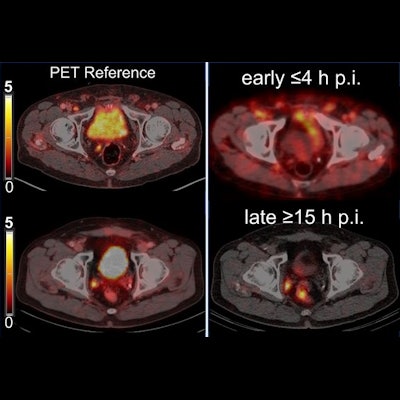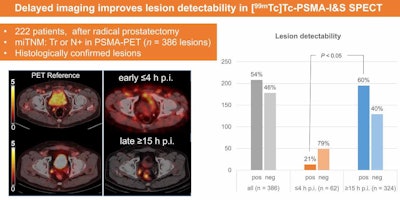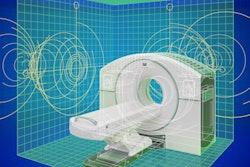
Delaying SPECT/CT imaging by 15 hours after radiotracer injection can enable the identification of more tumors in patients with relapsed prostate cancer, according to a study published May 25 in the Journal of Nuclear Medicine .
Researchers led Dr. Christoph Berliner of the University Medical Center Hamburg-Eppendorf in Germany found the approach was more effective than imaging patients between one and four hours after injections and recommend it as an optimal time to improve patient care.
"Late imaging (>15 hours after injection) should be preferred when Tc-99m PSMA-I&S SPECT/CT is used for lesion detection in early biochemical recurrence of prostate cancer," the group wrote.
A significant number of patients experience prostate cancer relapse after initial surgical treatment. Additional treatments in these patients, such as radioguided surgery, are used to target cancer lesions that have returned, the authors explained.
Technetium-99m (Tc99m) prostate-specific membrane antigen (PSMA) iodine and sulfur (I&S) is a radiotracer developed in 2016 for SPECT/CT radioguided surgery. Despite established use in these cases, the optimal time interval for injection of the tracer is unknown, the authors wrote. To that end, they aimed to compare early and late imaging to identify metastatic lesions in patients with early relapse.
The researchers reviewed databases at two centers and identified 222 patients who underwent radioguided surgery using Tc-99m PSMA-I&S SPECT/CT between September 2015 and April 2020. All patients showed signs of relapse based on high levels of prostate-specific antigen (PSA) blood marker. The researchers split the cohort into two groups -- patients who underwent early imaging (≤ 4 hours after injection) and patients who underwent later imaging (≥ 15 hours after injection).
 A visual abstract describing late SPECT/CT imaging for detecting tumors in patients with early biochemical recurrence of prostate cancer. Image courtesy of the Journal of Nuclear Medicine.
A visual abstract describing late SPECT/CT imaging for detecting tumors in patients with early biochemical recurrence of prostate cancer. Image courtesy of the Journal of Nuclear Medicine.Based on an analysis by two experienced nuclear medicine physicians, Tc99m-PSMA-I&S SPECT/CT had a significantly higher rate for detecting lesions in the late group (79%) compared with the early imaging group (27%), according to the findings.
Ultimately, although studies show the use of the approach is not as effective as PSMA-PET/CT, SPECT/CT scanners are less costly and more accessible in most parts of the world, the authors noted.
"[Tc99m-PSMA-I&S SPECT/CT] requires a two-day protocol and is still clearly inferior to PET/CT imaging for primary staging, but it significantly improves image quality and the detectability of pelvic lesions," the group concluded.



















